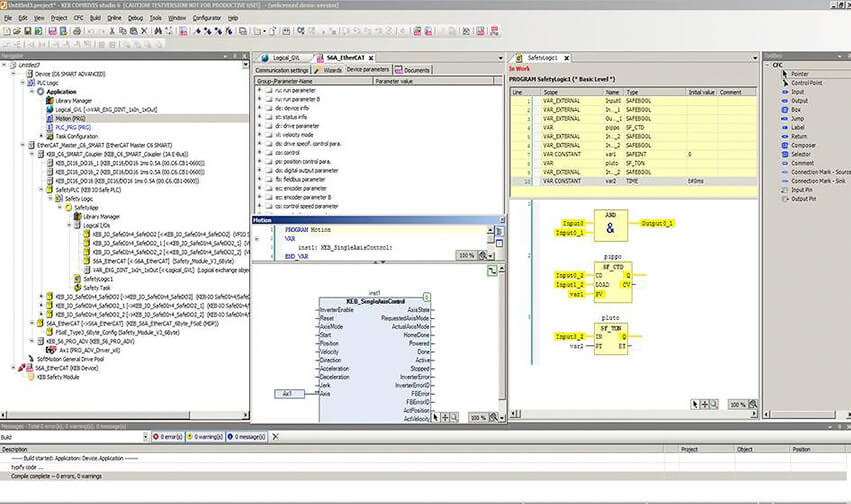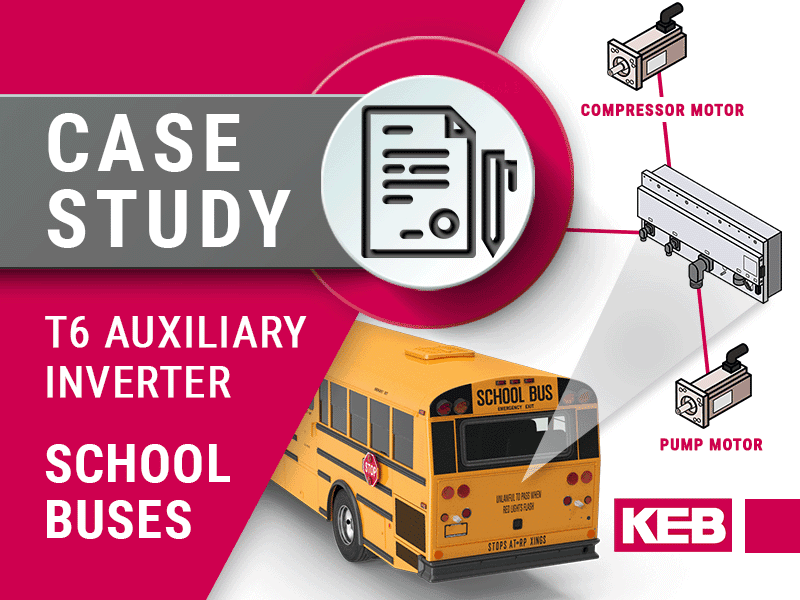The Benefits of an Embedded Controller for Auxiliary Inverters
Commercial electric vehicles generally have several auxiliaries which require electrification when de-coupled from a constantly running combustion engine. On the chassis, this typically includes the power steering pump and an air compressor for brakes and suspension. On the body, there can be a lot of variations of equipment from pumps for hydraulic systems to compressors for HVAC and refrigeration units. In any case, the number of auxiliaries on a commercial vehicle can really start to add up – and managing them all can present challenges.

In another article, I had previously written about the benefits of managing multiple auxiliaries from a hardware standpoint by utilizing a multi-axis inverter system. In this article, I will focus on the benefits of managing the communication and control of multiple auxiliaries with an embedded controller and some additional opportunities this can offer. Here, I will be using the KEB T6 auxiliary inverter as my point of reference since this is a multi-axis system with an integrated embedded controller.
Programmable and Custom Functionality
The basic function of a controller is to run a program. An embedded controller like the one on the KEB T6 system also supports the development environment (CODESYS-based) for creating logic control programs. These programs can range from simple, modular function blocks to complex, specialized programs.

As the manufacturer, KEB has pre-installed several application programs to allow for easy out-of-the-box user-startup for a variety of applications. One such application is a Torque/Speed Control program which automatically programs the inverter parameters for velocity and/or torque control and pre-configures the CAN process data mappings.
Watch the video above to see how the T6 App Pool functions as a customizable solution for programming electrified vehicle auxiliaries
In addition to programs created by KEB, third parties can develop their own custom application programs. This provides an opportunity for both OEMs and auxiliary manufacturers to create add-on functionality and embed their know-how into the system. Examples include startup and test routines or special modes of operation – such as reduced speed to conserve energy during low battery power.

Managing Multiple Auxiliaries – Independent Control and Communications
To support multiple auxiliaries, the T6 embedded control firmware was designed as a modular framework. This provides a flexible platform for a variety of auxiliary types by allowing the selection of a program for each motor control output. Thus, a program can be selected from a pool of available programs according to each particular auxiliary or the desired type of motor control – and provides independent control and operation of each motor. As an example, a three-axis T6 system could utilize a custom steering pump application program on one inverter output axis, a custom air compressor application on a second axis, and a simple velocity control application for a fan on a third axis.

To manage communications with the vehicle electronic controller unit (VECU), the embedded controller can also act as a CAN J1939 communications gateway for each motor control inverter stage. Here, each auxiliary motor control stage can have configurable transmit and receive process data mappings as well as configurable PGNs. This allows the user to determine what data they want to be communicated over the CAN bus – and allows them to manage the assignment and addressing. The gateway also allows the user to determine how the data is sent, via Proprietary A or B data format and likewise handles transport protocol messages accordingly.

Managing Third-Party Subsystems (with 2x CAN Controller Ports)
The T6 embedded controller is actually partitioned into two independent controllers, each with its own set of CAN ports. Where this feature is uniquely suited is combining separate T6 systems between manufacturers. This allows the benefits of combining the hardware (reduced cost, less cabling, less plumbing, etc.) without having to fully integrate the communications and control systems together; each system can continue to operate autonomously.

For example, a semi-tractor OEM may have a 2-axis T6 which is controlled by the main VECU for a steering pump and air compressor – and a trailer refrigeration unit (TRU) manufacturer may have a 1-axis T6 system controlled by its own electronic control unit (ECU) for the air compressor. The hardware of these two systems can be combined into a 3-axis inverter system, where each uses its own partition of the embedded controller. With this solution, the semi-tractor VECU controls its motors via a CAN J1939 gateway on one partition of the embedded controller, and the TRU EC controls its motors via a separate gateway on the second partition.

With multiple auxiliaries on commercial vehicles and numerous permutations of equipment for the variety of vehicle types, the ability to easily and flexibly manage these devices will be an asset for developers. This includes scalable and modular hardware solutions, as well as control and communication management solutions.
The KEB T6 Auxiliary Inverter system offers a solution that can support up to 6x motor control outputs and includes an onboard embedded controller which adds further value for managing a multi-axis system. This includes programmable functionality, allowing the selection of modular intelligent control programs for each independent auxiliary, J1939 CAN communication gateways to manage system communications with configurable data and addressing for managing the system, and two independent controller partitions to easily incorporate third-party systems.
T6 Auxiliary Inverter – Powering Next-Generation Electric Vehicles
The T6 inverter’s hardware and software features make it the ideal choice for vehicle manufacturers looking to electrify their auxiliaries. The T6’s powerful embedded controller gives a platform that OEMs can develop advanced functionality for their product. Separate communication ports allow it to be easily engineered into larger electrical and communication systems.
Want to learn more about how the T6 can help you electrify your vehicle? Contact a KEB T6 engineer today!
Let's Work Together
Connect with us today to learn more about our industrial automation solutions—and how to commission them for your application.




